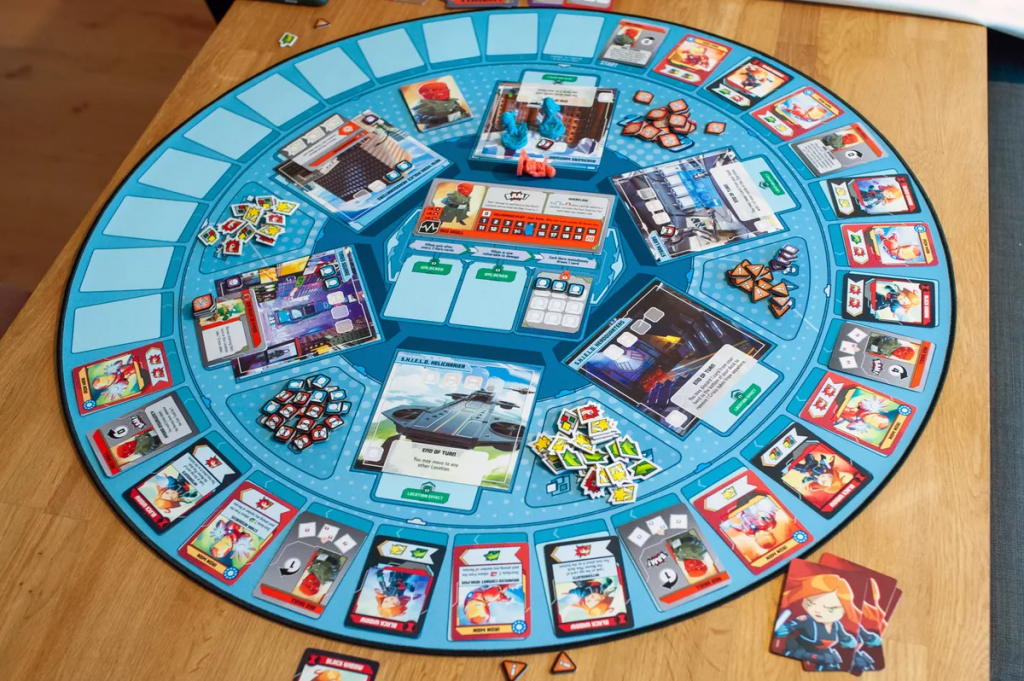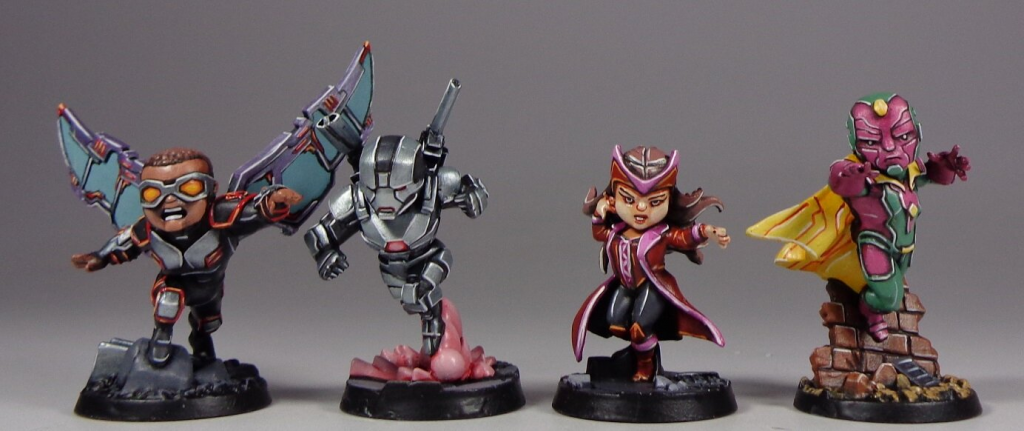Okay, we’re starting to get to some meatier games. That’s a trend that will likely continue, although today’s list is almost completely absent of short filler games. This section of the list also has some games with some of the best table presence on the list, and a reasonable amount of new blood – half of them have never made an appearance on my list before!
I’ve done some version of this list the last few years. Recently, though, my platform has been Twitter. Unfortunately, this year, Twitter has been turned into a raging dumpster fire of cryptospam and white supremacists after its recent purchase by the world’s Most Reply Guy Billionaire, who leadership seems hellbent on a mission to determine how far down the cliff his failures can cascade.
The upside of putting it on my blog is denying him the content, and also acts as a failsafe just in case Twitter explodes like a potato wrapped in tinfoil in the microwave. The downside is that I’m no longer limited to 288 characters per entry, which frankly was an underappreciated limitation now that I’m trying to churn these out.
Anyway, onto the list! Previous entries: 100-91 90-81 80-71 70-61
60. Maglev Metro
Released: 2021
Designer: Ted Alspach
Players: 1-4
Estimated Time: 60-90 minutes
Train games are nothing new. What IS new a train game where the subway map aesthetic reaches directly into your primal brain. Each player plays as a single colored subway line, and is given a pile of translucent tiles , when stacked on top of each other, provide a startlingly good facsimile of a classic underground map. And because of these translucent tiles, there’s no problem with train lines that run parallel with each other (somewhat unusual in many train games).

Maglev Metro is here largely based on its awesome table presence – people see the game and they want to play it. And for the most part, the game is intuitive and easy to understand (although it’s definitely a game where you’ll do a lot better on the second game once you intuit how scoring is handled). Still, a solid train game and one that will be better once the expansion with more cities comes out later this year.
59. Yedo
Released: 2012
Designer: Thomas Vande Ginste, Wolf Plancke
Players: 2-5
Estimated Time: 120-180 minutes
If your idea of a good time is being a Japanese crime lord, sending commands to a crew of ninjas while building up your own estate and collecting a bevy of geishas, Yedo may be the game for you. It’s a worker placement game very similar in feel to the classic Lords of Waterdeep – players try to accrue weapons and other resources necessary to complete quests, which are used to collect victory points.

My favorite design innovation of Yedo, though, is the Watchman. This AI-controlled enemy wanders around the board after all workers are placed, and he will arrest any of your agents that you deploy where he lands. His path is generally predictable and easy to avoid — USUALLY — but players can acquire cards that can manipulate where he lands, which adds a new level of ‘interactivity’ to the game — and by interactivity, I mean a layer of ‘go fuck yourself’.
58. Chai
Released: 2019
Designer: Dan Kazmaier, Connie Kazmaier
Players: 1-5
Estimated Time: 20-60 minutes
Chai is a relatively simple game where each player is a tea merchant managing their own personal tea shop. They’ll spend the game acquiring different kinds of tea (green, black, etc) as well as different kinds of flavoring (milk, honey, vanilla, etc) meant to disguise the fact that most tea tastes like drowned mulch.

Chai makes it on this list due to the nature of the market mechanic, which is simple and sweet. The market is a tile board of 18 tiles (3 rows of six) that get more expensive left to right. You can only buy one KIND of tea, but you can buy all instances of that tea on the market that touch each other orthagonally. Is there a row of four Mint tiles in a row? You can snap that up – if you can afford it. But you may well be making a similar opportunity for the next player when the board is fully refilled from your hefty purchase.
Chai is by far the lightest entry in the games we’ll look at, and if I were to describe it in one word, it would be ‘cozy’.
57. Oak
Released: 2022
Designer: Wim Goossens
Players: 1-4
Estimated Time: 60-90 minutes
Have you ever wanted to play dress up with little wooden meeples? Well, Oak may be the game for you. The sell point of this worker placement game is that you can advance your workers – in this case, hippie Druid types – with all sorts of festive adornments – a cape, a lute, a set of sweet deer horns. Each adornment will give your Druid cool and special powers, which can change how these workers can be placed (and the benefits thereof).

The rest of the game really centers on the vibe – use your druids to acquire resources, recruit wildlife and monsters to help you, expand your hippie drum circle, and climb the great Oak tree. For some reason, climbing the tree is the best way to get victory points for the end of the game, which I guess means my 4-year-old is just practicing for his future in an ancient Celtic order.
56. Dune Imperium
Released: 2020
Designer: Paul Dennen
Players: 1-4
Estimated Time: 60-120 minutes
Dune Imperium is a mashup of two interesting genres – worker placement and deck builder. On a player’s turn, they’ll play a worker and a card. The cards determine where the workers can go, and the players’ options are limited early on. You’ll need to acquire more cards, but you’ll never get enough cards – or turns – to be able to do everything, so you’ll need to choose a direction to lean your efforts. And all of this political maneuvering is done in an attempt to earn victory points, which is mostly acquired by winning battles in a very abstract war game, or kissing political ass.

Dune Imperium is a VERY good game that successfully merges two genres that don’t feel like they should fit together very well, but it’s not my favorite of this emerging genre (as we will see). That being said, it’s also an impressive feat that it’s a relatively simple game, and yet still manages to drip with favor for fans of the Spice Boys.
55. Anachrony
Released: 2017
Designer: Steven Aramini
Players: 1-4
Estimated Time: 30-120 minutes
This board game is the embodiment of “past me was an asshole, and future me is gonna have some problems.”
Anachrony is an imposing board to look at – a very meaty worker placement game with awesome mechs and a post-apocalyptic theme where your goal is to escape a dying earth before some cataclysmic event (the sun explodes, the waters rise, the McRib is permanently discontinued, something like that). And just on those merits alone, it should attract the attention of those who like very heavy euro games rich on theme.

But my favorite part of the game is that one of the tools humans have developed to help their escape is time travel. You can’t go back and kill Hitler or tell Elon Musk not to destroy Twitter, but you CAN go into the future and borrow resources from yourself. The only trick is you have to return those resources before you get to that point in the future, or Very Bad things happen, and by bad I mean ‘often hilarious but yes, very bad’.
54. Unsettled
Released: 2021
Designer: Tom Mattson, Marc Neidlinger
Players: 2-4
Estimated Time: 60-90 minutes
Unsettled is a tactical coop game, where you and your crew mates have all crashed onto a planet, and have to figure out how to get off. To do so, you’ll have to explore the landscape until you can find clues that let you uncover the objectives that provide the means to escape.
The trick, though, is that Unsettled comes with several game modules, and each of them is an entirely different puzzle. While the mechanics of the game are similar, the puzzle of the Ectoplasmic Goo Is Everywhere planet are radically different than the Lightning Storms All The Time planet, and even within those planets, there are different scenarios to further increase replay value. Every game is a tension of trying to figure out the contours of the scenario, trying to expose everything, but also trying to move FAST because every game has a serious clock.

But Unsettled is on this list for a very unusual reason for a board game – it’s the writing. Each module has specific moments – very light moments – of narrative and they are the perfect blend of serious, panicked, scientific and silly. In many games, hitting these narrative moments are a little eye-folly, but in Unsettled they’re a treat every time.
53. Merlin
Released: 2017
Designer: Stefan Feld
Players: 2-4
Estimated Time: 75 minutes
‘Roll and move’ games like Monopoly are widely despised by the wider board gamers community. Many hate how it feels like players have no control, and wins and losses can be too luck-based. Merlin seems to take these critiques as a challenge, and for the most part, hits a home run.

At the start of the round, players will roll four dice. On each turn, they will use one of their dice to move to their knight to a new location and do whatever action is depicted on that location. Thus, at the start of the round, the player will try to find the most optimal order to use their dice to gain more benefits. Along the way, they’ll also be accruing various power ups that allow them to mitigate the randomness (such as flipping dice).
The primary criticism I have of the game is – like many Euros – the theme is mostly pasted on. The mechanics of this game are very fun, deep and interesting but also thematically very bare. If what you want is a great King Arthur experience, you won’t find it here.
52. Lords of Vegas
Released: 2010
Designer: James Earnest, Mike Selinker
Players: 2-4
Estimated Time: 60-90 minutes
In every list like this, you have to throw in one old game that no one’s heard of just to give it some street cred, just to try to convince people you know all the deep cuts. In all honesty, it’s nice to pull an old game off the shelf and be reminded ‘oh yeah, this game was actually low-key kind of awesome!’

In Lords of Vegas, you will randomly be dealt a property each turn. After that, you can choose to build or upgrade properties, try to sprawl to neighboring properties, or even merge with another players casino and attempt to take it over. The end result is a game that turns into a knife fight very quickly. Down on your luck? Well, then, go to another player’s casino and try to gamble your way out of the hole!
There are several old classic games about building the Las Vegas strip, and this is my favorite. And I’d be remiss if I didn’t point out that there’s a Kickstarter for a new edition that’s up now that includes four new maps to challenge you.
51. Nemesis
Released: 2018
Designer: Adam Kwapinski
Players: 1-5
Estimated Time: 90-180 minutes
Cryo sleep has failed on your ship and you’ve awoken with a start. You and the crew are hurtling towards the black towards some unknown destination. That’s bad. Also, the ducts are infested with some sort of alien being that is Definitely Not A Xenomorph. That’s also bad. You’ll have to work together. Also, someone is probably trying to kill you.

Nemesis is a semicoop game, which is code for ‘game where everyone in general is trying to work together, but also everyone has secret objectives’. You may have an objective to steer the ship into the sun. Or you may have the objective to get an egg of the Definitely Not A Xenomorph onto the escape shuttle, where later you can figure out how to get it past customs and, presumably, the lawyers for 20th Century Fox. Or you may have the objective to kill the player to your left.
Needless to say, these objectives don’t always play nice with each other.
In all seriousness, Nemesis does a fantastic job of delivering the fantasy and panicked paranoia of living in an Aliens movie. And as an added bonus, almost every miniature you pick up and every card you draw is an opportunity to say ‘How did they not get SUED for this?’
Thanks for continuing to tolerate my mindless blathering. Do like a tweet or leave a comment if you have questions or comments. Stay tuned, 41-50 coming soon!


















































Recent Comments